Get to Know Your Healthy Lungs
Knowledge is Power
Take the time to learn about healthy lungs. It will help you to understand how COPD damages the lungs and how this lung damage affects the daily life of someone with COPD. Having a clear picture of what effect COPD has on the lungs will help you to maintain and improve your lungs health.
People with normal healthy lungs breathe 12-18 times a minute, that’s 20,000 time a day!
Oxygen is delivered to the lungs with each breath. Oxygen is your body’s fuel to maintain growth and repair every cell in your body. You need healthy lungs to keep your body working like it should.
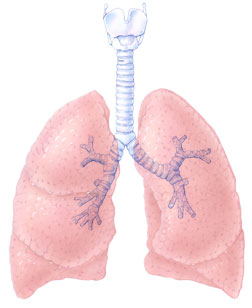
What Does the Outside of the Lungs Look Like?
You have a right and a left lung. Your heart sits in between the two lungs. The right lung is the larger lung and it has three distinct parts called lobes. There is an upper, middle, and lower lobe.
The left lung is smaller, as it has to make room for the heart. The left lung has only two lobes—the upper and lower lobe.
Image © peggerrity.com
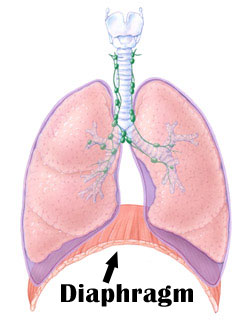 The Muscles of Breathing
The Muscles of Breathing
The diaphragm is the large curved muscle located below your lungs. It is the main muscle used in breathing. When the diaphragm drops down (contracts) and the rib cage expands, the air flows into the lungs. When the lungs are full of air, the diaphragm relaxes (goes back to its original position) and air is pushed out of your lungs.
There are other muscles in your neck and in between your ribs that also can help with breathing.
Image © peggerrity.com
The Muscles of Breathing
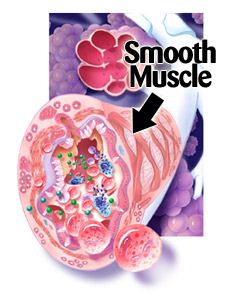
When you have COPD, the smooth muscles become stretched out; making it harder to breathe out all of your air. You may “trap” air in your lungs meaning that not all the air is exhaled from the lungs.
Asthma is a little different. In asthma the muscles, of the airway, tighten up (spasm) and your airways become narrow- and again it is hard to get the air out of the lungs. With asthma the airway muscles are not stretched out.
Working together all the muscles cause pressure changes inside of the lung that in turn helps move the air in and out of your lungs. Most of the time, people with healthy lungs do not have to think about breathing. Those with lung diseases have to work to breathe.
Image © peggerrity.com
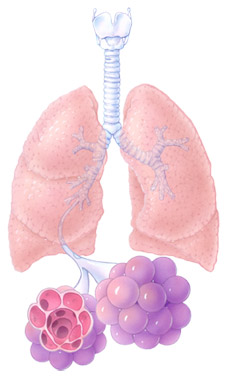
Moving the Air In and Out of the Lungs
Think of your lungs and airways as branches on a tree. Each breath you take enters the mouth or nose and travels down the windpipe (trachea) and into the two large airways (bronchi) that lead to the right or left lung.
Once the air enters the lungs, it goes through 22 smaller and smaller tubes until it reaches the tiniest tubes called the bronchioles. You have over 100,000 of them!
Finally the airflow travels from the bronchioles down to the 1,000,000 tiny air sacs (alveoli). These little air sacs look like clusters of grapes.
It is here in the alveoli where the oxygen (fuel) is delivered to the bloodstream and the carbon dioxide (waste) is removed. This process happens every time you take a breath and let it out.
Image © peggerrity.com
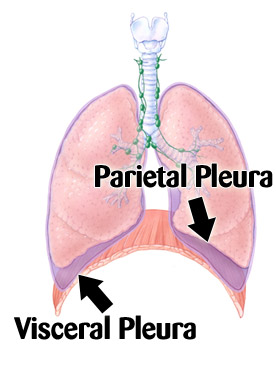
| |
 |
|
 |
Diseases Affecting the Pleura
Pleurisy: pain described as dull, achy, sharp, ‘a catch’, and/or burning
Pleural Effusion: fluid in the pleural space
Pleural Plaque and Thickening: usually, fibrous tissue
Pleurodesis: irritant is infused into pleural space to keep lung inflated
Pneumothorax: air or gas in the pleural space
Lung Cancer and Mesothelioma: generally related to asbestosis exposure |
 |
| |
 |
|
What Keeps the Lungs Inflated
The lungs are in a cavity that is protected by the ribs. The glue, so to speak, that keeps the lungs inflated is called the “pleura.” The pleura are two thin linings or membranes that protect and cushion the lungs.
One lining covers the lungs. It is called the visceral pleura—the other lining covers the chest wall, it is called the parietal pleura.
Between these two linings there is a small amount of fluid (pleural fluid) that lubricates the surface of the linings, so the two surfaces glide smoothly over each other.
It might be helpful to think of the linings as two pieces of glass placed on top of each other, one representing the lung pleural and the other piece being the chest wall pleural. If you set these pieces of glass one on top of the other they can easily be separated. But if you lightly coat the inside glass with water (pleural fluid), the pieces slide easily over each other and it becomes very difficult to separate the pieces of glass.
Image © peggerrity.com
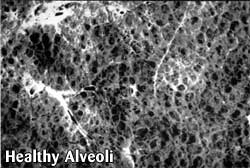 Take a Look Inside the Lungs
Take a Look Inside the Lungs
The lung resembles a sponge with tiny holes. It is made up 90% blood and 10% tissue.
Your lungs work best when they are clean. Keeping the lungs clean is very important in preventing infections and delivering oxygen to the body.
Normal, healthy lungs produce thin, clear mucus (a sticky fluid) to protect the lungs. When something irritates the lungs (dirt, fumes, or smoke) the lungs make more mucus to protect the delicate lung tissue.
Take a Look Inside the Lungs
Tiny hair-like structures, called cilia, beat fast enough to move the mucus up the airways. As the mucus moves up the airways, irritants stick to the mucus and it is removed with a cough or is swallowed.
Smoking damages the cilia. The useless cilia cannot move the mucus up the airways and as a result, mucus builds up in the lungs and becomes quite thick. This type of situation is leaves the lungs vulnerable to infections.
Irritants remain in the lungs when the cilia are damaged. The airways become swollen and narrow when irritants stay in the lungs for an extended period of time
Over time irritants that are not removed can destroy the lung's elastic ability, and the lungs become floppy, making breathing harder. The loss of elasticity decreases the lungs ability to exhale and air remains trapped inside of the lungs.